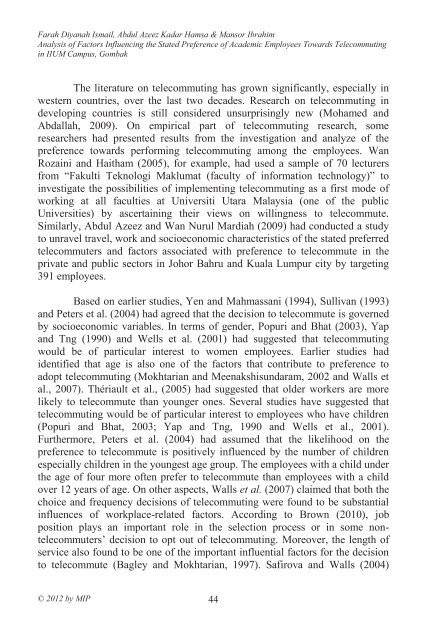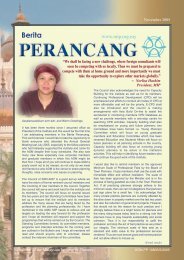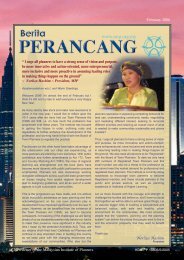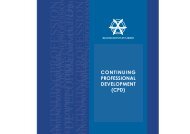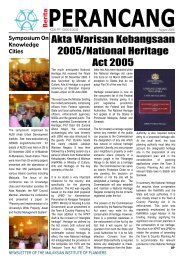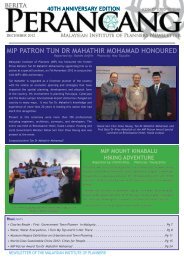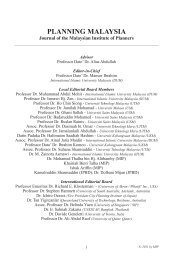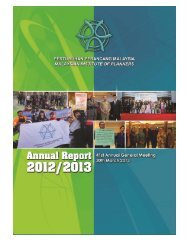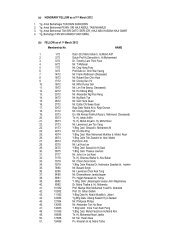Untitled - Malaysian Institute of Planners
Untitled - Malaysian Institute of Planners
Untitled - Malaysian Institute of Planners
Create successful ePaper yourself
Turn your PDF publications into a flip-book with our unique Google optimized e-Paper software.
Farah Diyanah Ismail, Abdul Azeez Kadar Hamsa & Mansor IbrahimAnalysis <strong>of</strong> Factors Influencing the Stated Preference <strong>of</strong> Academic Employees Towards Telecommutingin IIUM Campus, GombakThe literature on telecommuting has grown significantly, especially inwestern countries, over the last two decades. Research on telecommuting indeveloping countries is still considered unsurprisingly new (Mohamed andAbdallah, 2009). On empirical part <strong>of</strong> telecommuting research, someresearchers had presented results from the investigation and analyze <strong>of</strong> thepreference towards performing telecommuting among the employees. WanRozaini and Haitham (2005), for example, had used a sample <strong>of</strong> 70 lecturersfrom “Fakulti Teknologi Maklumat (faculty <strong>of</strong> information technology)” toinvestigate the possibilities <strong>of</strong> implementing telecommuting as a first mode <strong>of</strong>working at all faculties at Universiti Utara Malaysia (one <strong>of</strong> the publicUniversities) by ascertaining their views on willingness to telecommute.Similarly, Abdul Azeez and Wan Nurul Mardiah (2009) had conducted a studyto unravel travel, work and socioeconomic characteristics <strong>of</strong> the stated preferredtelecommuters and factors associated with preference to telecommute in theprivate and public sectors in Johor Bahru and Kuala Lumpur city by targeting391 employees.Based on earlier studies, Yen and Mahmassani (1994), Sullivan (1993)and Peters et al. (2004) had agreed that the decision to telecommute is governedby socioeconomic variables. In terms <strong>of</strong> gender, Popuri and Bhat (2003), Yapand Tng (1990) and Wells et al. (2001) had suggested that telecommutingwould be <strong>of</strong> particular interest to women employees. Earlier studies hadidentified that age is also one <strong>of</strong> the factors that contribute to preference toadopt telecommuting (Mokhtarian and Meenakshisundaram, 2002 and Walls etal., 2007). Thériault et al., (2005) had suggested that older workers are morelikely to telecommute than younger ones. Several studies have suggested thattelecommuting would be <strong>of</strong> particular interest to employees who have children(Popuri and Bhat, 2003; Yap and Tng, 1990 and Wells et al., 2001).Furthermore, Peters et al. (2004) had assumed that the likelihood on thepreference to telecommute is positively influenced by the number <strong>of</strong> childrenespecially children in the youngest age group. The employees with a child underthe age <strong>of</strong> four more <strong>of</strong>ten prefer to telecommute than employees with a childover 12 years <strong>of</strong> age. On other aspects, Walls et al. (2007) claimed that both thechoice and frequency decisions <strong>of</strong> telecommuting were found to be substantialinfluences <strong>of</strong> workplace-related factors. According to Brown (2010), jobposition plays an important role in the selection process or in some nontelecommuters’decision to opt out <strong>of</strong> telecommuting. Moreover, the length <strong>of</strong>service also found to be one <strong>of</strong> the important influential factors for the decisionto telecommute (Bagley and Mokhtarian, 1997). Safirova and Walls (2004)© 2012 by MIP 44


